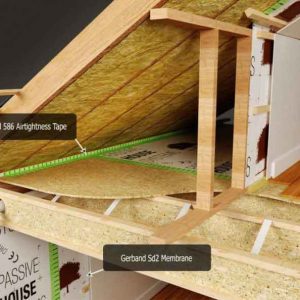Timber frame construction allows for achievement of excellent levels of air permeability.
However, extra attention has to be given to the design of the airtightness in timber frame, to be effective. Unlike masonry or concrete construction, where inherently airtight materials are used, timber frame construction requires the use of an AVCL (Airtight vapour control layer) membrane, this also has to protect against interstitial condensation.
For the airtight membrane to be effective it needs an appropriate installation. Taping membrane overlaps, window and door frames. Sealing penetrations, bridging over intermediate floors. Also sealing to the ground floor can help you achieve the expected results.
With timber frame, creating a continuous layer is all the more important as weak points in the airtight vapour control layer may cause interstitial condensation, resulting in degradation of building materials.
Protecting the AVCL in timber frame construction is crucial.
The penetrations can be detrimental to the air permeability and thus the buildings efficiency. Battening out from the membrane before applying plasterboard, can protect the airtight layer. Applying horizontal battens on the tape joints strengthen them and is the best approach. You can use good quality, airtight OSB of 18mm as the airtightness layer, and seal joints with tape.
Fixing the airtight layer to a substrate is an important step. Using staples to fix an airtight membrane may cause small levels of air leakage. That may make the difference of achieving a highly sought-after airtightness level and not. Using a double-sided tape may be the preferred option over staples and the only option when applying to steel. An alternative to using double sided tape on timber is to use staples. You can always patch over using a universal joining tape.
Bridging an intermediate floor can be done a variety of ways, the ideal solution is to wrap the joists with a scrim reinforced membrane to protect the airtight membrane from tearing. You may also tape individually the floor joists to the membrane but this is labour intensive.
Passive house systems can supply a complete airtight system for timber frame and provide technical support throughout the project.
We’re very proud of the quality of our services. Our technical support is consistent with BS 9250 (Code of practice for design of airtightness). It also complies with DIN 4108-7 (Airtightness of buildings – requirements, recommendations and examples).We’re able to supply materials and available to provide technical support for airtightness and vapour control regardless of the type of construction.

